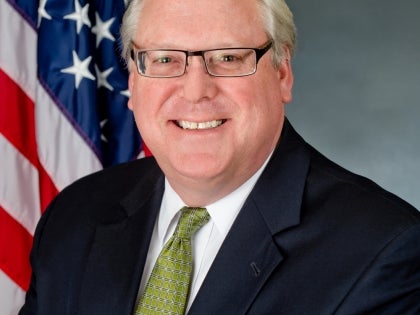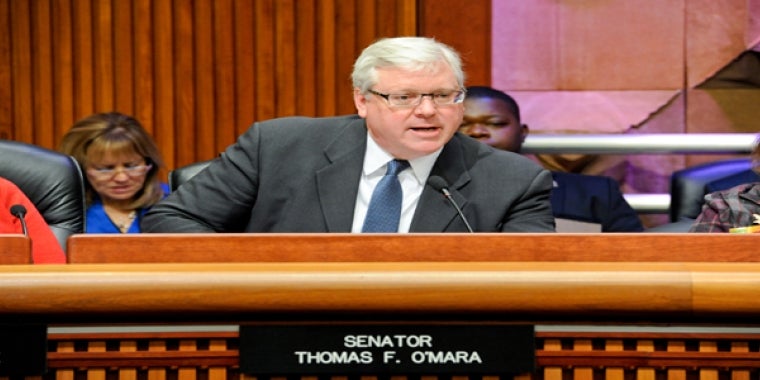
O'Mara: Budget includes tax relief, record support for local schools, stronger infrastructure commitment & combat heroin funding ~ But minimum wage increase overshadows many of budget's highlights

Senator O'Mara raises questions at one of this year's legislative budget hearings.
Albany, N.Y., April 1—State Senator Tom O’Mara (R,C,I-Big Flats) said that the 2016-17 state budget includes additional middle class tax relief, provides record aid and eliminates the Gap Elimination Adjustment (GEA) for local schools, increases support for local infrastructure, and secures additional state funding to strengthen the response to New York’s burgeoning heroin crisis.
The state Senate completed action on the new budget earlier this morning. The Assembly is scheduled to adopt the final pieces of the 2016-17 state budget later today and send it to Governor Andrew Cuomo to be signed into law. The approximately $156-billion fiscal plan remains within the Legislature’s self-imposed, two-percent spending cap.
“The good news about this budget is that it includes middle class tax relief, eliminates the GEA and provides record support for local schools, and increases funding for local roads and bridges, and local water infrastructure improvements,” said O’Mara. “It’s also critically important that this budget strengthens the state’s commitment to local heroin and opioid addiction prevention, treatment, recovery and education services.”
O’Mara, a member of the Senate Task Force on Heroin and Opioid Addiction, strongly praised the budget’s inclusion of increased funding, approximately $166 million, to continue to enhance and expand the state’s heroin and opioid addiction prevention, treatment, recovery, and education services statewide. He said the budget reflects input he and his colleagues have received at numerous local public forums they’ve conducted since 2014, including one in late February in Penn Yan (Yates County).
“It’s going to remain important to hear directly from those on the front lines locally who can help us keep targeting the necessary responses, and I was grateful for their participation in Yates County in February. The local input we've been receiving will spur the continued work of the Senate task force and help our state continue to build on and strengthen the state-local partnership that's going to be critical to putting in place the most up to date and effective combination of law enforcement, awareness and education, and treatment and prevention. That’s reflected in this budget," said O'Mara.
But O’Mara stressed that the highlights of the state’s new budget are overshadowed by the budget’s inclusion of a plan to phase in a minimum wage increase. O’Mara and a number of his Senate Republican colleagues, especially those representing upstate regions, staunchly opposed the aggressive campaign in support of the highest-in-the-nation statewide minimum wage pushed by the governor, New York City Mayor Bill de Blasio, and other advocates since late last year. They were able to beat back Cuomo’s original plan and slow down its impact upstate. Under the approved wage plan – and only after strong resistance from a group of Senate Republicans including O’Mara -- the upstate wage will increase to $12.50 in five years. Any annual increases after that time will be indexed and could be stopped through a formula set by the Division of Budget in consultation with the state Labor Department that will examine the economic impact of the higher minimum wage on local economies.
“I’ve strongly opposed this action, fought against it until the bitter end, and helped achieve some concessions to try to ease its impact upstate. We were outnumbered and all the while threatened by Governor Cuomo that he would institute a $15 minimum wage across the state through the wage board like he did with fast food workers last year,” said O’Mara.
O’Mara, who chairs the Senate Environmental Conservation Committee, said that the new budget includes a fully funded, $300-million Environmental Protection Fund (EPF), something many conservation advocates have been fighting for for years. The EPF supports critical environmental initiatives including clean air and water projects, flood control and restoration, and open space preservation. This year’s increase also provides additional funding to fight invasive species, including establishing a matching grant fund for municipalities and others to treat aquatic invasive species such as Eurasian Milfoil.
“It helps create local jobs and studies have shown that for every dollar of EPF funds invested in land and water protection, the state and localities get back seven dollars in economic benefits. That's a pretty solid investment by any measure. The EPF enjoys an impressive record of government investment which has benefitted a broad-based segment of New York’s citizens and communities like very few government programs ever have,” O’Mara said. “Strengthening the EPF to the fullest extent possible within the context of the entire state fiscal plan makes great economic and environmental sense. It will be an enduring and proud achievement for future generations of New Yorkers and New York communities.”
The budget also includes a $200-million increase for the “Water Quality Infrastructure Improvement Grant Program” established last year to help localities undertake water infrastructure improvement projects including sewer and municipal water line repairs.
Also on the environmental front, O’Mara said the budget will include a rebate program for consumers and municipalities who purchase electric and “zero-emission” vehicles. The rebate program contained in the budget mirrors legislation O’Mara introduced earlier this session and would provide up to a $2,000-per-vehicle rebate for individual buyers and a $5,000-per-vehicle rebate for local municipalities. Rebates would also be granted to municipalities for building related infrastructure, such as charging stations and hydrogen refueling stations.
Other 2016-17 budget highlights include:
> an overall increase of nearly $1.5 billion in state aid to public schools, bringing total state aid to education to a record $25 billion. It includes the complete elimination of the remaining $434 million of the controversial Gap Elimination Adjustment (GEA), which has cost school districts locally and statewide billions of dollars in state aid over the past several years, as well an approximately $627-million increase in Foundation Aid. The GEA has been a particularly damaging and highly controversial move first enacted in 2009 that has hurt school districts locally and statewide over the past several years. The GEA was originally enacted in 2009-2010 by then-Governor David Paterson, and when both houses of the Legislature were under Democratic control, as a way to help the state close a multi-billion-dollar budget gap. Republicans in the Senate at that time unanimously rejected the move as a budget-balancing scheme that would hurt local school districts. O’Mara noted that state Senate Republicans have been committed to fully eliminating the GEA over the past several years.
“It’s about time,” said O’Mara. “The elimination of the unfair and detrimental Gap Elimination Adjustment has been a top priority for our local school districts, and it’s been a top priority for Senate Republicans. It’s a priority I’ve strongly shared and I’m glad that we’ve finally done away with something that never should have been imposed on districts in the first place.”;
> O’Mara said that for the first time since 2010 there will be parity in funding between the five-year state Department of Transportation (DOT) and Metropolitan Transportation Authority (MTA) capital plans, with each plan slated to receive approximately $27 billion.
It includes $438 million in direct funding for the Consolidated Highway Improvement Program (CHIPS) with an additional $400 million over four years ($100 million a year) of funding for local roads, delivered through the CHIPS funding formula, from a new PAVE NY program for local roads and $400 million over four years from a new BRIDGE NY program for local bridge projects that will be determined with local input. Combined, the funding will provide increases to counties, cities, towns and villages across the Southern Tier and Finger Lakes regions, and statewide for local roads and bridges.
Earlier this session O’Mara and Assemblyman Phil Palmesano (R,C,I-Corning), as they have for the past several years, organized a bipartisan group of 130 senators and members of the Assembly who joined county and town highway superintendents and other local leaders from throughout the state to call for increased support for local roads and bridges. They noted that local roads and bridges account for 87% of the roads, 52% of the bridges, and 48% of the vehicle mileage logged in New York State.
“The improvement and upkeep of local roads and bridges is a wise use of taxpayer dollars. It’s an investment in economic growth and job creation throughout the Southern Tier and Finger Lakes regions, and all across New York,” said O’Mara, a member of the Senate Transportation Committee.;
> a new, $1-billion “Middle Class Income Tax Relief Program” first proposed by Senate Republicans earlier this session that will enact a phased-in series of rate reductions for middle class taxpayers, including thousands of small businesses who file under the Personal Income Tax. Beginning in 2018 under the new plan, middle income tax rates will begin a phased-in reduction that will drop rates to 5.5 percent when the cuts are fully effective after seven years. The lower tax rates will save middle class taxpayers nearly $6.6 billion in the first four years, with annual savings reaching $4.2 billion by 2025, or an average savings of $700 per year per taxpayer. The new rates will represent New York’s lowest middle class tax rates in more than 70 years and will benefit 6 million filers when fully phased in.;
> additional provisions of the Senate’s “Grown in New York” plan, which O’Mara has co-sponsored for several years, a comprehensive legislative program blending tax and regulatory reform incentives, low-interest loans and grants, an expanded student loan forgiveness program and other initiatives to help existing farmers stay on the land and encourage more young men and women to consider careers in agriculture. This year’s budget, for example, extends the “Beginning Farmers” grant program and also establishes the “Dairy Promotion Act” to try to help strengthen the largest sector of New York’s leading agricultural industry and stabilize the prices being paid to state dairy farmers through more aggressive education, promotional, and research and development efforts, among other initiatives including the issuance of dairy promotion orders.
O’Mara, a member of the Senate Agriculture Committee, said that it’s especially important that the Senate budget restores more than $9 million for agricultural program cuts proposed by Cuomo impacting 30 different programs. Since 2011, O’Mara and his colleagues have initiated budget restorations and funding for new ag programs totaling more than $32 million.
O’Mara added that the Senate budget includes $115,000 for an innovative proposal by Cornell’s Small Farms Program that the Senate proposed earlier this year to help establish up to five veteran-owned small farms through a first-in-the-nation pilot program. Returning veterans and those seeking a career change could be encouraged to try agriculture, utilizing benefits they’ve earned under the GI Bill to gain training and expertise to begin their own successful small business. In turn, these sites would be available to train additional veteran-farmers in future years;
> increasing community college base aid by $100 per full-time equivalent student (FTE), making the base aid $2,697 per FTE for 2016-17, resulting in a $20 million aid increase for community colleges statewide, including Corning, Tompkins Cortland and Finger Lakes; and
> The Senate’s Task Force on Lyme and Tick-Borne Diseases, on which O’Mara serves as a member, established a few years ago to help combat this growing health concern, secured $600,000 for additional research, education, and prevention efforts.



